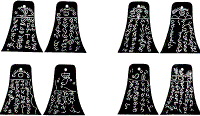
The Kinderhook Plates were an archaeological hoax designed to embarrass the Mormons by tricking their leader, Joseph Smith, into "translating" phony hieroglyphics written on them.
The plates were six bell-shaped pieces of flat copper, unearthed from an Indian burial mound near Kinderhook, Illinois in April 1843. The hieroglyphics were inscribed on the front of the plates. The plates were supposedly found buried beside the skeleton of a man.
Joseph Smith, who was living sixty miles away in Nauvoo, did examine the plates, but there is controversy about whether he attempted to translate the hieroglyphics. Some reports state that he did. An account published in the Mormon
Deseret News in 1856 stated that Smith translated a portion of them and found them to contain "the history of the person with whom they were found. He was a descendant of Ham, through the loins of Pharaoh, king of Egypt."
However, the Mormon Church denies Smith ever made a translation.
The hoax was later revealed to be the work of three men — Wilbur Fugate, Robert Wiley, and Bridge Whitton — who lived near Kinderhook. According to a letter written by Fugate, the trio had heard a prophecy by Mormon Elder Orson Pratt that "truth is yet to spring from the earth", and they decided to "prove the prophecy by way of a joke."
Whitton, who was a blacksmith, made the plates, and Wiley, a local merchant, pretended to discover them in the Indian mound.
Links and References

 The Kinderhook Plates were an archaeological hoax designed to embarrass the Mormons by tricking their leader, Joseph Smith, into "translating" phony hieroglyphics written on them.
The Kinderhook Plates were an archaeological hoax designed to embarrass the Mormons by tricking their leader, Joseph Smith, into "translating" phony hieroglyphics written on them.
Comments